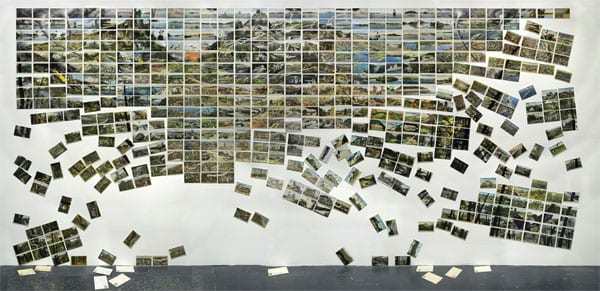
January 18, 2018; New York Times
Later this week, an art show opening at the University of Michigan’s Institute for the Humanities will feature works by emerging artist in residence David Opdyke, including a new piece titled “This Land,” which is more than 16 feet wide and 8 feet tall.
Opdyke fashioned his massive collage out of more than 500 postcards from the first third of the 20th century. But his message is very much focused on the state of the environment in the first third of the 21st century, with alarming images of what might transpire in the not-too-distant “dismal future into which we all seem to be sleepwalking,” in Opdyke’s words.
“This Land” is made from vintage postcard images described by Lawrence Weschler in the New York Times as “portraying a distinct slice of idealized Americana. Town squares, mountain highways, recently completed dams, main streets and county seats, lakes and rivers, forests and farmsteads: intimations of a prodigiously gifted country positively breasting its way into a confident future.”
At least that’s what the postcards portrayed before Opdyke “layered in a whole series of diminutively painted interventions of his own.” The artist has at first glance created a giant landscape, what Wechsler calls “a crisp, lush pastoral expanse.” But even from a distance, the viewer can see that this landscape is in trouble, with bits of the mosaic crumbling away and some bits even spilling onto the floor below. The wide view calls to mind a line from “The Second Coming,” penned by William Butler Yeats a century ago: “Things fall apart; the centre cannot hold.”
Sign up for our free newsletters
Subscribe to NPQ's newsletters to have our top stories delivered directly to your inbox.
By signing up, you agree to our privacy policy and terms of use, and to receive messages from NPQ and our partners.
Up close, the pastoral expanse dissolves into fragments, with current environmental realities like forest fires, tornadoes and seemingly endless traffic jams mixed in with nightmarish images like a plague of locusts, frogs raining from the sky, and sports stadiums converted into water reservoirs. The entire vista is punctuated by graffiti, as well as floating blimps advertising seats on The Ark and biplanes trailing banners with such messages as “Legislative Action Would Be Premature.”
It’s an incredibly ambitious and clever project from an artistic standpoint. But it’s intended to be much more than that. It’s meant as a wake-up call to anyone who sees the work to get serious about environmental issues and get involved in preventing Opdyke’s frightening future scenarios from becoming real.
Opdyke admits he sometimes doubts the power of art to effect such change. “I’m constantly haunted by worry. Can such artistic gestures ever really make any difference, especially given the sheer scale of the challenge?”
Every artist who’s ever created anything meant to effect change—a film, a song, a poem, a play, a mural—has almost certainly harbored the same kind of doubts. Opdyke quotes Eudora Welty, who said that “Making reality real is art’s responsibility.” And he observes that “maybe that’s what most needs doing now: making the stakes involved in our current crisis real and tangibly visible for people. One ends up hoping that pieces like this might propel the urgent changes in vision, one person at a time, necessary to provoke an appropriate mass response.”
“This Land” can be seen on Opdyke’s website in high-resolution, and it’s configured so the viewer can zoom in and out, looking at segments of the larger work as well as the fine details of the altered postcards and the often-ironic juxtapositions of images and words.—Eileen Cunniffe













